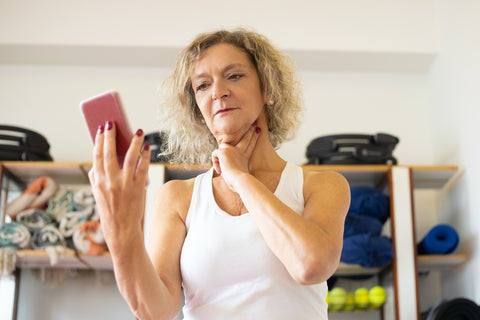
First, you'll want to find the best place to feel your pulse. Be active for a minute or so in any manner you wish, take a brisk walk, or climb a flight of stairs, to amplify your pulse. Now explore the following:
The radial artery in your wrist is just inside your wrist bone at the base of your thumb joint.
A carotid artery on one side of your throat, either just above your collarbone or below your jaw. Remember, don't close off the second carotid artery on the other side while you're doing this: you may shut down the blood supply to the brain.
A temporary artery at the side of your forehead (temple) just in front of your ear. Again, press on one side only. Most people prefer the radial artery in the wrist. If that's the system you elect, use the following procedure:
Place your wristwatch on your wrist so that you can see its face when the palm of your hand is up. Next, place the wrist on which you have your watch in the palm of your thumb and forefinger. Let the tips of your fingers curl toward your thumb. Now your third and fourth fingers will rest over your pulse. The little pads at the ends of those fingers will fit right into the groove of the wrist. The pad on your middle finger is the pulse "feeler". If you press slightly against the wrist with your fingertip feeler, you should be able to find your pulse. Don't panic if you can't find the pulse at first; it takes a few minutes of practice.
What you feel at each beat is not blood flow, but a pulse wave that moves along the arteries about twelve to eighteen feet per second.
Doctors and nurses use one of several methods in taking the pulse: counting it for one minute, counting it for thirty seconds and multiplying by two, or counting for fifteen seconds and multiplying by four. We use still another method: counting for six seconds and adding a zero. We do this for a good reason. A longer count is more accurate in general terms and is ideal for taking the pulse of someone at rest. But a long count does not tell us about your exercise response as accurately as does a 6 seconds count taken immediately after the exercise. Then the pulse )(and heart) is beating at a rate that most nearly reflects the exertion you achieved during your movements. Within 15 seconds, the pulse has diminished from that peak, within 30 seconds still more, and within a minute still more. the variation between the pulse rate immediately after exercise and the rate one minute later can be as much as 30 beats.
You're now going to determine your pulse rate by counting the number of pulses in 6 seconds and adding a zero to get the per-minute rate. Catch the rhythm of pulsations for a while. When your pulse coincides with an easy time interval (at one of the five-second marks), start counting. Begin with "Zero" as the second-hand crosses over the five-second mark. If you don't say "zero" you'll miscalculate. Then count the number of pulses in six seconds.
Reference:
Laurence E. Morehouse, Ph.D. Total Fitness in 30 Minutes a Week. Simon and Schuster, 1975.
